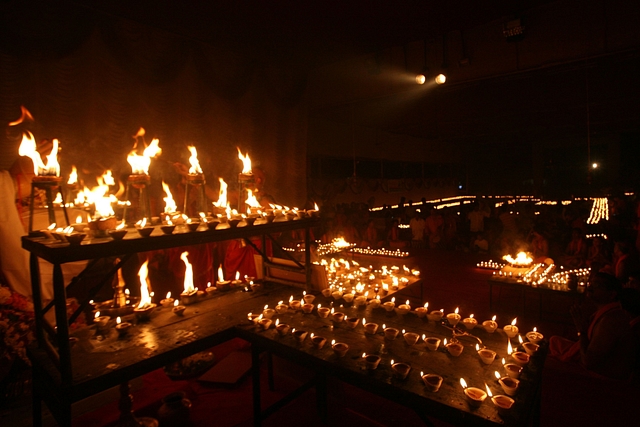
The Lamps And The Cosmic Pillar
The night of Kartik Poornima. The lighting of lamps, diyas. The dispelling of darkness, both inside and outside.
Did you know that all of this is inextricably intertwined with the traditions of Shiva and Murugan-Skanda?
Today, we light lamps. These are small earthenware lamps with oil and small cotton wicks. For this is Thiru Karthikai - the auspicious day for Murugan.
Lamps symbolise knowledge. And there are two kinds of knowledge - the para vidya and apara vidya - knowledge of the self and those considered non-self. It is also called vidya and avidya. Both take us ultimately to liberation and the binary should never be set against each other. The Isavasya Upanishad cautions that one who cares for only one type neglecting the other always ends in darkness - each darkness comparably worse than the other. With avidya one crosses mortality and with vidya one attains liberation or immortality.
Tamil tradition illuminates this harmony of inner and outer knowledge ending in the divine liberation through the beautiful hymns of Azhwars. Poigai Azhwar sings of lighting a lamp for Vishnu. For this, he uses the earth itself as the lamp body, entire ocean as the ghee and sun as the flame. Illuminated through such a lamp, the Azhwar offers the garland of melodious hymns so that Vishnu would eliminate the ocean of obstacles.
Bhuthataazhwar, who was adjacent to him, then sang of illuminating a lamp in which the body of the lamp was love and the zeal for God-realisation being the ghee, and the wick being the mind itself. He lighted this lamp of knowledge with his own Atman melting in the process. Here we see that both through para-vidya and apara-vidya or through vidya and avidya they reach the same goal - the realisation of Vishnu - the ultimate all pervasive Godhead that is both immanent and transcendent.
Similar to Azhwars the Shaivaite Nayanmar Appar also speaks of placing a lamp to realize Sivan. Inside the temple of the body, the mind becomes the lamp with the awareness being the ghee, and the life itself becoming the wick. The flame lighted is the flame of knowledge. That lamp shall reveal the feet of Sivan.
Thirumanthiram, another sacred Shaivaite corpus considers Shiva himself as the eternal lamp (Thirumanthiram-48). If Sivan is the eternal lamp, there are also lamps within us says Thirumanthiram. The lamp of the mind should be lit to shine while the fire of wrath should be made to get extinguished. All the inner lamps should be kindled to shine bright (through dhyana). In such a state, the lamp of the mind becomes non-the dying lamp. (Thirumanthiram-602). Abirami Bhattar, an eighteenth century Shakta mystic from Tamil Nadu speaks of the Goddess as the inner light and also the body of the lamp that holds the light.
So as the lamps light up the Karthikai night, the lights shine both physically and in the inner space.
A Shaivaite legend speaks of both Vishnu and Brahma going in search of the beginning and end of the column of fire that is Shiva. The placing of the Ishtadevata as superior to the three deities and the weaving of Puranic narratives should be understood as a form of devotional exercise rather than as religious upmanship because of sect rivalry. In the Arunachala Hill, the Karthikai Deepam would be lit today. The Atharva Veda has beautiful hymns addressed to Skambha - the cosmic pillar called Skambha Sukta. Here, he is spoken of as the ‘base for rta - the cosmic harmony’ and he ‘firmly holds the six directions’. The day and night are depicted as two maiden of ‘different colours’ who ‘for him run forth in mutual understanding.’ All deities are seen as part of his body and so are the Vedas.
This cosmic deity who is also very abstract - transcending beyond the binaries of the manifest and unmanifest, while at the same time also harmonising them in itself - is in the form of the fiery pillar - the axis of the universe itself. The Agni-born Murugan, with six faces and two consorts resonates with Skambha. The Annamalai Deepam, where Shiva is seen as the fiery column along with the Karthikai festival for Murugan shows a deep connection and identity of Murugan-Skanda with Shiva as the cosmic pillar.
Skambha is also spoken of as ‘Brahmanyam Mahat’ - the mighty or high Brahman. Subrahmanya is the name of Murugan-Skanda. In the history of spiritual concepts of India, the Skambha Sukta has an important place. It envisions the Brahman-Atman identity. Skambha is both ‘Brahmanyam Mahat’ and is also realised by the wise seekers as ‘brave, undecaying youthful’ (‘atmanam, dhiram, ajaranm and yuvanam’) - a description that is very well expanded in Skanda Purana and in the depictions of Skanda-Murugan. An ancient form of Murugan worship in Tamil Nadu documented in Sangham literature is the Kanthu-worship which is actually akin to Linga worship. This may well then be related to the Skambha hymn of Atharva Veda.
Thus the lamps lit today are the lamps of inner light which is also the Atman and which is also in Shiva-Advaita of Shaiva Siddhanta, that which forms the very source from which the manifest and the unmanifest arise.